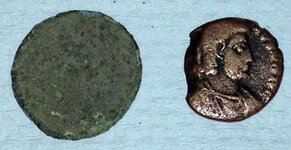 After about a half-hour in the solution and some vigorous rubbing with olive oil, the coins were visibly “cleaner.” (Providence Hall photo)
After about a half-hour in the solution and some vigorous rubbing with olive oil, the coins were visibly “cleaner.” (Providence Hall photo)Is the crusty material on an ancient Roman coin “old dirt” or “oxidized metal”?
In a lesson crossing the humanities and physics curricula, Providence Hall humanities teacher Bruce Rottman and science teacher Laura Schultheis recently team-taught freshman students a lesson about ancient Roman coins and using the principles of electrolysis to clean the coins.
Rottman began the class session with a lesson on the fall of Rome in 476 A.D., the resulting loss of millions of coins under layers of dirt, and the eventual recovery of those coins by modern-day treasure hunters.
Cleaning Ancient Coins a Lesson in History, Physics for Freshman at Providence Hall





